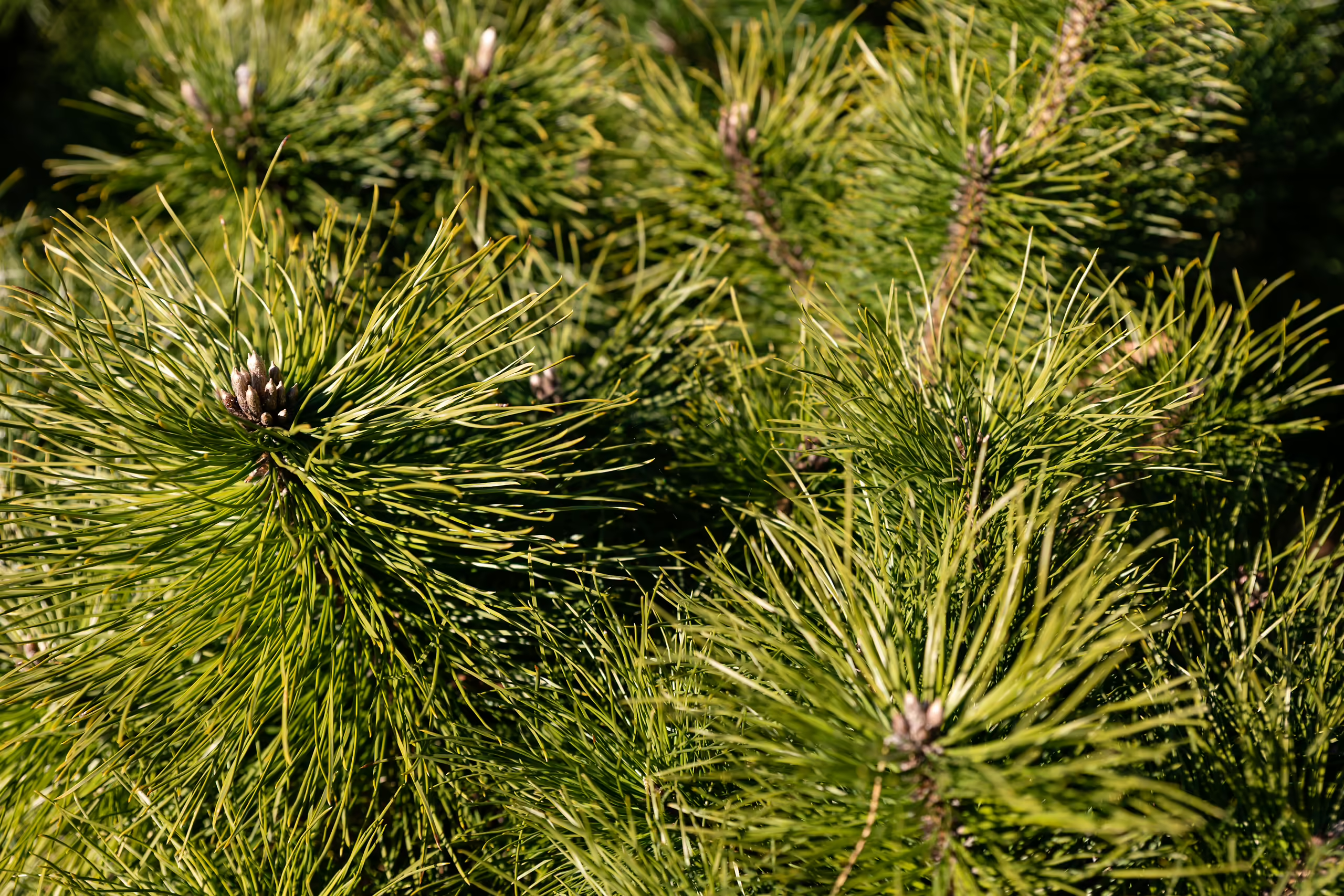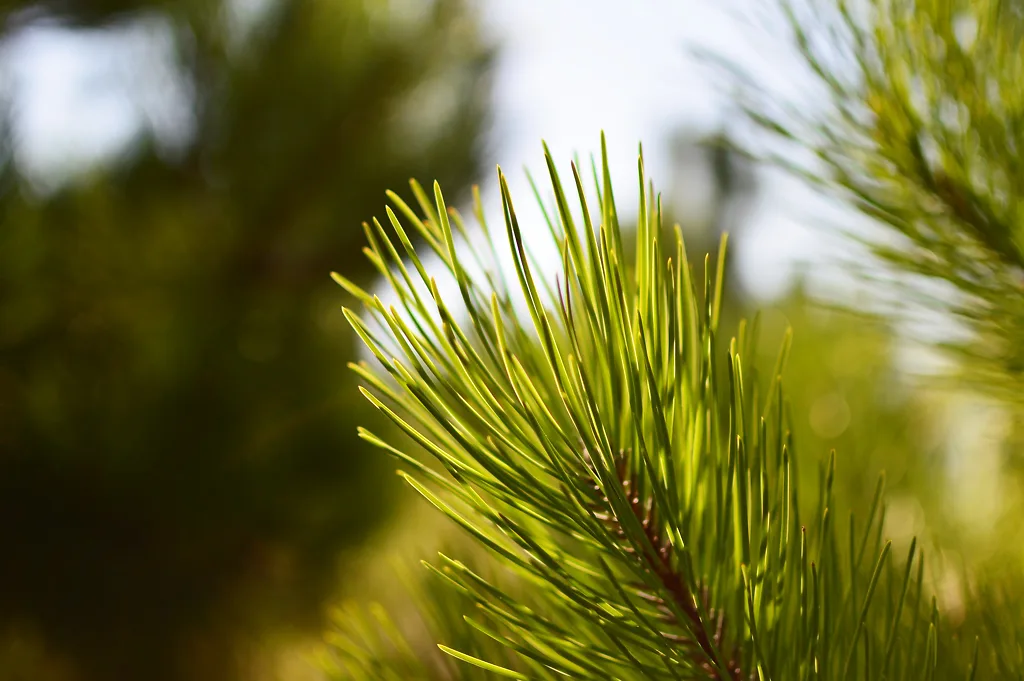
Written by s • Pine Trees – Some Great Choices for Your Garden
Pines are certainly the most easily recognized evergreen, with their distinctive long and thin needle-like leaves and large cones. For the garden they offer a wide range of trees and shrubs, that fit into many garden styles, and grow well even in poor, sandy soils. With all that diversity available, there is hardly a garden anywhere that can’t be enhanced with a pine tree, so let’s take a look at some of the fascinating and beautiful choices available for you to pick.
Pines are a group of trees within the plants called conifers. Their name in Latin – Pinus – is easy to remember, and it is an ancient name for these trees. It means ‘resin’, and all pines release an aromatic sticky substance that hardens into a coating over wounds, (and on our hands!). Pine trees range from shrubby plants just a few feet in height, to towering trees well over 200 feet tall. The first pines appeared about 150 million years ago, and the modern group evolved around 50 million years later.
The Big Groups of Pines

Botanists divide pine trees into two big groups, based on the arrangement of the needles. At first glance it looks like pine needles stick out all over the branches, but if you look more closely you will see that they are clustered together in bundles, with a little papery covering over the base where they are attached to the stem. Some pines have five needles in the bundle, while others have either two or three. The five-needle pines usually have hard wood and are often called ‘hard pines’. The others usually have softer wood, and they are called ‘soft pines’, or ‘white pines’. Hmm, maybe botany is not so hard after all!
The soft pines are in turn split into two groups, with one growing throughout Europe and across into Asia and Japan, and another in North and Central America. The hard pines are also split into two groups, with one group in southwestern America and Mexico, and another group found all through the Northern Hemisphere.
For gardeners it perhaps makes more sense to look at pines based on where they come from – Europe, Asia, or North America, and we will take that approach here, although the botanical splits are useful too, involving not just needle numbers, but cone characteristics too. Understanding them is necessary for accurate identification (especially if the tree has no label).
European Pine Trees
There are three important garden pines that come from Europe, and two of them are very widely planted, and seen in many gardens and landscapes. As well as their ‘wild’ forms, they are found in several garden forms that can look very different, and that make attractive garden plants.
Austria Pine – Pinus nigra
This is one of the most commonly planted pine trees in the north-east, and it can be seen not only in gardens, but even more in park and landscape settings, as it will grow in tough conditions, taking poor soil, salt spray and urban pollution in its stride. It is also very cold hardy, and even grows well up in chilly Alberta, Canada. The Austrian Pine is sometimes called Black Pine, because the needles – in bundles of two – are very dark green, and stiff. The bark too is dark, and this tree has a dense branch structure too, making it a good choice for screening, compared to other more open-structured pines. The variety called ‘Oregon Green’ is a smaller, compact form with brighter green foliage.
A striking and useful variation of the Austrian Pine is called ‘Arnold Sentinel’, and it has a dense, upright, columnar pattern of growth, making it very useful in a smaller garden, as a specimen on a lawn area, or at the back of a bed. It is just as tough as the natural tree, although perhaps not quite as winter hardy.
Scots Pine – Pinus sylvestris
This is a much taller tree, and older trees almost always develop a tall, branchless trunk, with a rounded crown of foliage high up in the air. Surprisingly, they can also be trimmed into an attractive hedge, and kept low, with branches to the ground. If you plant them to grow naturally – and they are beautiful trees, with soft, long needles and richly-colored bark – remember that they will naturally lose their lower branches in time.
Scots Pine also has a narrow, upright columnar form, called ‘Green Penguin’, which grows just a few feet tall and makes a charming accent in a pot or small garden – very cute!
Mugo Pine – Pinus mugo
Very different from other pines, this tree grows as a rounded shrub, that is usually just a few feet tall, although older plants can become bigger. It is widely used in gardens for foreground planting, or scattered among rocks, and its rich green coloring and dense growth is always eye-catching and appealing. The form, ‘Carsten’s Wintergold’ has golden needles through the coldest months, and is a real collector’s item.
American Pine Trees
Rocky Mountains Bristlecone Pine – Pinus aristata
If you want a tree to plant for the future, this has got to be the ultimate choice. In the wild these trees live literally for thousands of years, so your great-great-great-great grandchildren might be able to enjoy it. Although slow-growing, even small trees are very attractive, with short dense needles packed around the stems, and an angular ‘ancient’ look. It is hardy in zone 2, and it should be planted on dry, rocky or sandy soil, if you want it to live for a long time.
White Pine – Pinus strobus
This is the classic pine of the north-eastern states, growing all around the great lakes. It often takes on dramatic, windswept forms, with a tall trunk and spreading crown. It grows easily in gardens, and makes a handsome lawn specimen, growing up to 2 feet a year. If you have heard about it being subject to disease (blister rust), don’t worry, because the scientists tell us it has been almost eliminated in most places, and no longer poses a significant risk.
Like many other pines it too has a dwarf variation, which looks a little like a mugo pine with soft, light, blue-green needles. It’s a lovely specimen for a small bed, or around a pond.
Ponderosa Pine – Pinus ponderosa
If you are looking for large, rugged trees for a larger garden or property, look no further than the Ponderosa Pine. Growing in time well over 100 feet tall, this is not a tree for a small garden, but an investment in a green future. Easy to grow and cold hardy, this is the very essence of what a pine tree should be.
Asian Pine Trees
Pine trees play a big part in Chinese and Japanese gardens, often trimmed and trained into niwaki – giant bonsai trees growing right in the ground. As well as being essential for any Asian garden, these pines are often tough, reliable plants for general gardening too.
Japanese White Pine – Pinus parviflora
This beautiful small pine tree usually grows no more than 40 feet tall. It is a little choosy as to where it is happy, growing well only in zones 5, 6 and 7, and needed regular rainfall. But if you can grow it, do so, as you will love it graceful elegance, and softer look than is seen in most pines.
Japanese Black Pine – Pinus thunbergii
Much tougher than the Japanese white pine, this tree is the perfect choice for seashore locations, and it will grow right at the waterline. It also grows well in hotter and more humid conditions, so it’s a great choice for those areas. It is a two-needle pine, with blackish-gray, deeply grooved bark, which gives this tree a rugged and ancient look, even when quite young.
Summing up. . .
This is just a sample of the more than 100 different pines, not counting all the garden variations. You can grow a large selection in most gardens, and they are great low-maintenance trees, always with lots of character. Plant one today.





